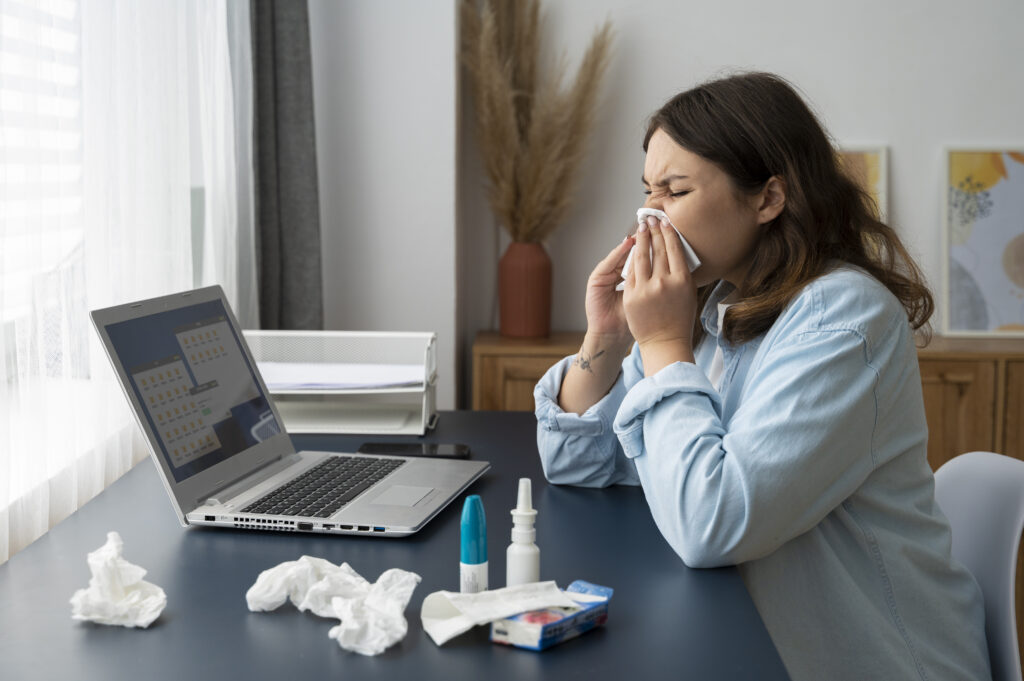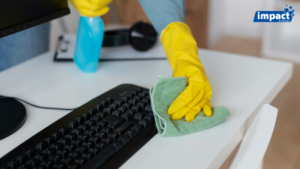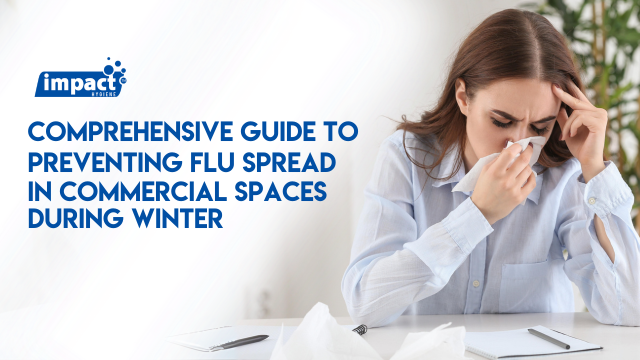Did you know?
Flu season strikes every year in the fall to winter months and infects about a billion people worldwide, according to the World Health Organisation (WHO).

The World Health Organisation reveals that there are around a billion cases of seasonal influenza annually, including 3–5 million cases of severe illness. In Australia, the influenza season happens usually between May and October as monitored by the Australian Government Department of Health and Aged Care.
The winter season in Melbourne brings cooler temperatures and, unfortunately, an increased risk of influenza (flu) outbreaks in commercial environments. Flu outbreaks can lead to significant disruptions, not just in terms of health, but also by affecting productivity and overall workplace morale.
The good news? Many of these consequences are preventable with proactive measures. Throughout this blog, we’ll explore effective strategies that can help keep the flu at bay, ensuring that your work environment remains healthy and energetic.
Understanding the Flu – A Brief Overview
Influenza (the flu) is a viral infection that can be serious for some people, but if you are otherwise fit and healthy you usually don’t need to see a doctor, as explained by Healthdirect Australia, the national virtual public health information service.
Let’s find out more about the flu and how it impacts our overall health.
What is the Flu and How Does it Spread?
Influenza, commonly known as the flu, is a respiratory illness caused by influenza A or B viruses. It affects the nose and throat and may also affect the lungs. It manifests in symptoms ranging from mild to severe, including fever, cough, sore throat, and muscle aches.
Seasonal influenza, or the flu, is a sharp respiratory illness triggered by influenza viruses (WHO / K. Mostafa, 2023). It occurs worldwide and most individuals recover from it without needing medical treatment.
The WHO identified 4 types of influenza viruses: types A, B, C and D. Influenza A and B viruses circulate and cause seasonal epidemics of disease. WHO also notes that flu symptoms usually begin around 2 days after being infected by someone who has the virus which may include:
- sudden onset of fever
- cough (usually dry)
- headache
- muscle and joint pain
- severe malaise (feeling unwell)
- sore throat
- runny nose
The Transmission
The Minister for Health and Wellbeing in Southern Australia or the SA Health explains that, the flu virus transmits through small droplets released into the air when an infected individual talks, coughs, or sneezes. Infection may also be spread by contact with hands, tissues and other infected articles.
In commercial settings, influenza spreads mainly through droplets from infected individuals transmitting the virus when opening their mouths. Surfaces touched by many people, like door handles and elevator buttons, can also harbour the virus, making thorough cleaning and hygiene practices essential in these environments.
The Impact of Flu on Businesses
Flu significantly affects workplaces, leading to increased absenteeism and decreased productivity. A study by Zumofen et al. (2023) entitled, “Impact of Influenza and Influenza-Like Illness on Work Productivity Outcome” discloses that the flu (‘influenza’) has an effect on patients, their families, employers, and society. The authors also revealed that 75% of employees missed work when they had the flu or a flu-like illness.
In Australia, influenza accounts for approximately 3,500 deaths, over 300,000 GP consultations, and 18, 000 hospitalizations on average each year, according to the NSW Ministry of Health. A private study also reveals that absenteeism due to sickness is costing Australian businesses $7 billion annually. These statistics prove the need for proactive flu prevention strategies to maintain operational efficiency and protect financial interests.
The same study by Zumofen et al. confirms earlier work by Keech and Beardsworth, showing that the flu significantly lowers work productivity worldwide. Despite differences in how these studies were conducted and what they measured, the results clearly show that the flu has a major impact on workers, employers, and the economy.
Key Strategies for Flu Prevention in the Workplace

The Center for Disease and Control Prevention (CDC) mentions that employees are an invaluable asset to any business and that they play a vital role in preventing flu outbreaks in the workplace. Let’s uncover more precautionary measures to prevent the spread of flu in the workplace.
Enhancing Cleaning and Hygiene Protocols
Regular and comprehensive cleaning protocols are essential in preventing the spread of the flu. These include:
- Hand Hygiene Stations – Install hand sanitising stations throughout the workplace, especially in high-traffic areas. Encourage employees to use them regularly by providing visible signs and reminders.
- Personal Hygiene Reminders – Personal hygiene is the first step to preventing the spread of germs and staying healthy. Regular reminders about personal hygiene can significantly help implement office-wide measures. These may include sending out regular communications via email or company newsletters or short verbal reminders during meetings and huddles.
- Regular Sanitisation – Increase the frequency of cleaning common areas and frequently touched surfaces such as doorknobs, elevator buttons, and shared places and equipment. It’s also crucial to maintain clean and well-stocked restrooms. Clean restrooms are vital as they are high-traffic areas where germs can easily spread through surfaces like faucets, door handles, and soap dispensers.
Utilising Impact Hygiene‘s services ensures that all these areas are not only cleaned but sanitised with professional-grade products. Our advanced cleaning solutions and techniques, such as the Impact Clean™ service, provide thorough sanitisation, maintaining a hygienic restroom environment that minimises the risk of flu infection and supports overall workplace wellness.
Optimising Indoor Air Quality
Good air quality reduces the concentration of airborne pathogens, including flu viruses, thus decreasing the risk of transmission. The CDC advises that air quality can be improved by bringing in fresh outside air, purifying indoor air, or gathering outdoors. Cleaner air can reduce the risk of exposure to viruses.
- Increase Ventilation – During Melbourne’s milder winter days, whenever possible, open windows and doors to bring in fresh outside air. This natural ventilation helps dilute and remove airborne contaminants.
- Air Purification – Consider incorporating air purifiers with HEPA filters, particularly in high-occupancy areas. HEPA filters are highly effective in capturing and trapping airborne particles, including flu viruses, improving overall indoor air quality.
- Gather Outdoors (Weather Permitting) – Melbourne’s winter offers pockets of pleasant weather. When possible, encourage meetings or breaks to be held outdoors. This provides a natural way to improve ventilation and reduce the risk of airborne transmission within your workspace.
Ensuring that HVAC systems are properly maintained and incorporating air purifiers with HEPA filters can significantly improve air quality and contribute to a healthier workplace environment during winter months.
Implementing Employee Health Safeguards
Australian WHS (Work Health and Safety) laws place a legal responsibility on businesses to ensure the health and safety of their workers, and to avoid putting the health of others at risk. This aligns perfectly with the concept of implementing employee health protocols explained in the succeeding sections, while fulfilling your WHS obligations for your business in Melbourne, especially in the winter season.
Encouraging Flu Vaccination Among Employees
According to WHO, vaccination is the best way to prevent influenza. The flu vaccine is the first line of defence against the flu. Vaccinating employees not only reduces flu cases but also diminishes the severity of the illness if contracted.
Businesses can facilitate flu vaccinations by organising vaccination drives at the workplace and providing flu shots at no or reduced cost to their employees. Healthdirect Australia mentions that it is important to get the influenza vaccination each year to continue to be protected, since it wears off after 3 to 4 months and flu strains (types) change over time.
Educating Employees on Personal Preventative Measures
Building a culture of health responsibility can significantly decrease the incidence of flu in the workplace. Educational programs that encourage good personal hygiene practices, such as regular hand washing, using tissues when coughing or sneezing.
Staying home when sick is also an important preventive step. CDC recommends workers with suspected or confirmed flu illness stay home from work. Specifically, staying at home for at least 24 hours if employees are sick, are strictly recommended.
Leveraging Professional Cleaning Services
Effective cleaning by professional cleaners reduces the presence of viruses and other pathogens that can lead to disease outbreaks. Professional cleaning services help in maintaining a high standard of hygiene with specialised cleaning techniques and products, thus significantly contributing to flu prevention.
Businesses that have engaged professional cleaning services often notice a marked improvement in employee health and a decrease in sick days. A study by Solomon et al. (2019) concluded that hiring professional cleaning services has positively impacted on the quality of cleaning in institutions.
WorkSafe Australia also confirms that effective cleaning needs suitable cleaning methods, schedules, equipment, trained cleaners and reliable communication and consultation. Professional cleaning companies possess all these elements and can ensure a comprehensive and consistent cleaning regimen that goes beyond what most employees can achieve individually.
The Role of Professional Cleaners in Flu Prevention
Professional cleaning services play a pivotal role in mitigating the risk of flu in commercial spaces. By employing specialised cleaning techniques and high-grade disinfectants, these services can significantly reduce the presence of flu viruses on surfaces and in the air, thus lowering the likelihood of flu spread among employees.
- Air Quality Improvement
Many professional cleaning services also offer air duct cleaning and air purification solutions, which can help remove pathogens from the air and improve overall indoor air quality, further reducing the risk of respiratory illnesses. - Customised Cleaning Protocols
Based on the specific needs of a workplace, professional cleaners can develop customised cleaning protocols that focus on high-touch areas like door handles, light switches, and communal devices, which are hotspots for virus transmission. - Deep Cleaning and Disinfection
Professional cleaners use TGA-approved disinfectants known to kill flu viruses. They perform deep cleaning that targets every nook and cranny, something that regular cleaning staff might overlook. Clean restrooms in particular need more disinfection, as they are critical points of germ transmission in any facility.
Impact Hygiene, with over 20 years of experience in corporate washroom hygiene services, understands the importance of maintaining these areas meticulously. We use specialised disinfectants and cleaning programs, ensuring your restrooms are not just clean, but hygienically safe specially this winter.
Contact us today and experience how this cleaning thoroughness helps prevent the spread of flu and other infections, protecting the health of your employees and visitors.
Choosing the Right Cleaning Partner

When selecting a professional cleaning service, it is important to consider their expertise in handling hygienic cleaning and their ability to customise services to your specific needs.
Here are some essential tips to guide you in choosing the right partner:
- Check for Certifications and Standards
Ensure that the cleaning company adheres to industry standards and holds relevant certifications, which indicate their commitment to quality and safety. These are an objective indicator of their commitment to quality service, safety protocols, and effective flu prevention strategies. - Evaluate Their Experience
Look for a company with a proven track record in commercial cleaning, particularly within Melbourne’s facilities. Years of experience demonstrate their understanding of industry best practices and their ability to adapt to diverse cleaning requirements. - Assess Their Flexibility
The ability to tailor services to your business’s specific needs is crucial. A good cleaning partner should offer flexible scheduling and customised cleaning plans. - Consider Their Equipment and Supplies
Make sure they use high-quality, effective cleaning products and equipment that are also safe for your environment.
For corporate restroom cleaning, Impact Hygiene, with 20 years of experience, excels in delivering top-notch washroom hygiene services. Independent lab tests prove that our Impact Cleaning machines are up to 60 times more effective at removing bacterial contamination than mops and other regular cleaning tools.
Planning and Response Strategies for Flu Season
Developing a Flu Response Plan for Your Business
As flu season approaches, it’s crucial for businesses to be prepared with a robust flu response plan. This plan not only helps in managing outbreaks effectively but also minimises disruption to your operations. Here are the key elements to consider when crafting your plan:
- Risk Identification
- Assess the potential impact of flu on your workforce and operations.
- Identify key roles and positions critical for maintaining essential services.
- Communication Strategy
- Develop clear communication channels to update employees on flu outbreaks and procedures.
- Ensure all employees know whom to contact if they exhibit flu symptoms.
- Vaccination and Prevention
- Encourage or facilitate flu vaccinations for employees.
- Educate staff on hygiene practices such as frequent hand washing and proper cough etiquette.
- Sick Leaves and Remote Work Options
- CDC and WHO strictly recommends infected people to stay home to avoid infecting others.
- Determine which positions can operate remotely to minimise the spread of the virus.
- Ensure the necessary technology and security measures are in place to support teleworking.
- Sanitization Protocols
- Increase the frequency of cleaning and disinfecting in high-touch areas.
- Provide adequate supplies like sanitizers, tissues, and no-touch trash bins.
- Response and Containment
- Define procedures for responding to employees who become ill at work.
- Implement policies for sick leave and returning to work post-illness to avoid spreading the virus.
- Risk Identification
An effective flu response plan outlines specific actions to be taken before, during, and after the flu season. It should include strategies for increasing cleaning frequency, managing sick leave, and communicating with employees about outbreaks.
Monitoring and Adapting to Flu Season Trends
Staying informed about local flu trends and public health recommendations allows businesses to adapt their prevention strategies in real time. Tools like flu surveillance systems can provide valuable insights into when the flu season is starting, peaking, and tapering off, enabling timely adjustments to response plans.
The Australian Government Department of Health and Aged Care monitors influenza activity and severity in the community. Healthdirect Australia is the national virtual public health information service. Managers and business owners can subscribe for newsletters or updates from these authorities and other health organisations for public health advisories and recommendations. This greatly helps businesses to stay updated about the flu season and gain advanced insights in preventing the outbreak in the first instance.
Conclusion: Staying One Step Ahead of the Flu
Maintaining a healthy work environment requires vigilance and proactive measures, especially during the flu season. The flu can significantly impact commercial spaces, affecting everything from productivity to employee well-being. Recapitulating, the importance of flu prevention cannot be overstated—especially in environments where many people gather, like workplaces.
Here are some final thoughts on keeping your commercial spaces flu-free:
- Understand the Risk – Recognizing the severe implications of flu outbreaks is the first step towards prevention.
- Be Proactive – Implement the discussed strategies diligently before and during the flu season. Remember, vaccination is still the best way to prevent the disease according to WHO.
- Customise Your Approach – Adapt the strategies to fit the unique needs and dynamics of your workspace.
As winter approaches, now is the time to take proactive steps towards a healthier season. Clean, sanitised workplaces are not just about aesthetics—they are about safety and efficiency.
Ready to enhance your workplace’s flu defences? Contact Impact Hygiene today for a comprehensive restroom cleaning plan that can significantly help your efforts toward flu prevention. Let us help you maintain a healthy, productive environment this flu season and beyond.





